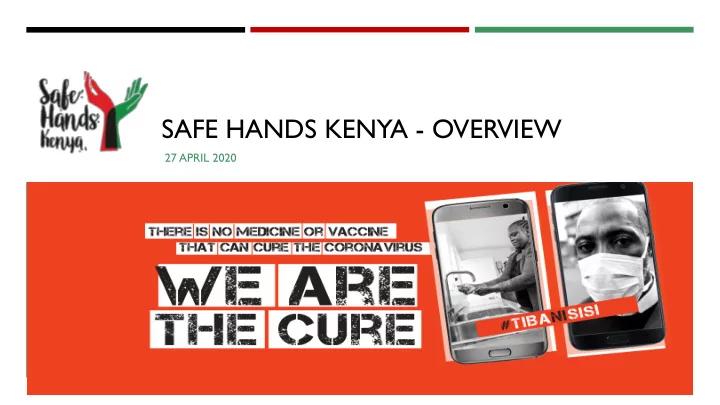

SAFE HANDS KENYA - OVERVIEW 27 APRIL 2020
The Problem: COVID-19 risk is highest in low-income communities with limited sanitation – and social distancing will not work Population with no handwashing facilities in or near the home For millions in Kenya, social Baringo 93 Bomet 92 Bungoma 80 distancing will not work in the fight Busia 77 Elgeyo Marakwet 91 Embu 85 against COVID-19. Garissa 91 Homa Bay 86 Isiolo 61 Kajiado 73 Three big problems prevent this: Kakamega 92 Kericho 85 Kiambu 59 Kilifi 84 Kirinyaga 79 1. Lack of sanitation options , e.g. Kisii 97 Kisumu 82 Kitui 90 running water, sewerage Kwale 93 Laikipia 80 Lamu 80 management. Machakos 84 Makueni 95 Mandera 93 Marsabit 93 Meru 65 2. Unavoidable physical proximity Migori 96 Mombasa 81 Murang’a 91 in informal communities Nairobi 56 Nakuru 81 Nandi 90 Narok 95 Nyamira 95 3. Economic fragility forces people Nyandarua 88 Nyeri 80 Samburu 98 to work despite health potential Siaya 78 Taita Taveta 63 Tana River 88 health risks. (Daily Wage Tharaka-Nithi 86 Trans Nzoia 93 Turkana 93 Workers) Uasin Gishu 86 Near Handwash Vihiga 84 Wajir 98 No Handwash West Pokot 94
Typical Low Income Neighbourhoods KIBRA Background: Estimated to be the largest informal settlement in Africa. Housing: 12’ x 12’ shack, 6 -7 pple Area: 2.5 KM 2 Population: 300,000 – 500,000 DANDORA Background: Principle dumpsite for Nairobi city, enviromental and waste related hazards. Area: 4 KM 2 Population: 110,000
Objectives: Provide products immediately – at no cost – and with depth and breadth of reach The coalition partners will commit to 3 guiding principles: 1 2 3 Suspension of the “Last mile” Speed profit motive saturation This project will ensure The project’s supply chain bypass The project aims to provide vulnerable Kenyans access traditional flows to respond to products to all Kenyans, especially critical sanitation products at urgent need and provide quick those in at-risk communities and no cost mitigation to the crisis hard to reach areas T o sustain an intervention of this scale, the coalition will have a fully-funded supply chain for the duration of the crisis
The solution: Rapid mass sanitation via three-pronged approach Large-scale distribution of 1 FMCG products: soap, hand sanitizer, surface disinfectants and Masks RAPID MASS 2 SANITATION Sewage extraction 3 Water supply This project is focused on large-scale distribution of FMCG sanitation products
Consumer behavior: Adopt best practice to spur behavior change Project will ensure every Kenyan, particularly those in hard to reach ACCESS areas, are able to access the products by leveraging organizations community trust and extensive last-mile distribution The project will sensitize end-users on the importance and effective CONSUMER usage of hygiene and sanitation products by using right medium, content, and a EDUCATION compelling message The project will leverage human-centered design principles to shape USER product and delivery design improving adoption, tracking distribution at a EXPERIENCE granular level, and ensuring a learning feedback loop
Unique Approach to a Unique Problem Weights 40% 25% 5% 0% 25% 5% Share of Population Density Latrine use (all No water piped Makeshift ESI informal (% of highest) types), % into dwelling, % Houses, % employment Sublocation code Location Subloc Population 11224 SILANGA KIBERA SILANGA 17,363 36.6 60% 31% 93% 95% 99% 11271 GATWIKIRA SERANGOMBE GATWIKIRA 24,988 47.8 72% 25% 96% 99% 97% 11231 LAINI SABA LAINI SABA LAINI SABA 28,180 47.2 64% 29% 98% 95% 99% 13272 MATHARE 4A RUARAKA MATHARE 4A 18,776 51.8 73% 27% 42% 96% 74% 11222 LINDI KIBERA LINDI 35,143 47.1 59% 26% 98% 95% 99% 13253 NYAYO KOROGOCHONYAYO 9,835 44.4 44% 34% 91% 98% 87% Data Driven Approach to Prioritization • Weighted Indeces Economic Security • • Pop. Density Employment • • Water/Latrine Availability • Home Structure Fully visible ‘last mile’ coverage of distribution Network Only SHK have visibility •
We have rolled out a major consumer awareness & behaviour change campaign – #TibaNiSisi (“We are the cure” in Swahili) Campaign involves both above- and below-the-line activities: Significant creative content development and distribution via partners • (posters; TVCs; print newspaper ads; billboards; radio) • Large social media presence for #TibaNiSisi brand • Engaging celebrity influencers around campaign – initially in Kenya
Messaging is targeted at driving best practice adoption & positive behavioural change in a way that is relevant to target audience Posters reinforce behaviour change messaging and dispel myths Example content from SHK partner on the correct use of Celebrity influencers used to face masks amplify campaign & demonstrate correct product use Online content relates best practice back to viewers’ life, challenging them to adapt their own behaviours
All on-ground activities and consumer engagement falls under the #TibaNiSisi brand. Cleaning team from local partner in Dandora (Nairobi) prepare to use Handwashing at one of the handwash stations delivered by SHK disinfectant spray in public areas Disinfecting handwash stations at local shops Residents read #TNS hygiene signage Grafitti artist paints mask messaging Disinfecting public spaces and playgrounds at entry gate to compound
Achievements (SHK & Coalition Partners) 54,000 Bars of Soap, 2,000 Lts Sanitizer & 2,000 Lts Surface Disinfectant (Kibra) Door to Door Delivery with SHOFCO 110,000 Bars of Soap, 3,000 Lts Sanitizer + 8,000 Lts Disinfectant (Dandora) Public Hand Washing Stations Public Area Sanitization 200,000 Masks (TBD) All of Nairobi Informal Settlements Coverage by End May (2,7m pple)
Challenges/Learning Changing Regulatory Landscape Ease of Movement Regulation on food/material donations Inputs Importation of inputs at scale Local & Global Availability Be Ready to Plug in Multiple efforts, all solving for the greater good. Move Fast But Be Agile There is no Silver Bullet
Coalition Members as of 27 th April 2020 INPUT SUPPLY CONSUMER PRODUCTION DISTRIBUTION CHAIN EDUCATION LEADERSHIP & PROJECT MANAGEMENT
Thank You
For more information on AVPA & our various initiatives please contact one of the following individuals: South Africa: Dr. Frank Aswani – faswani@avpa.africa Kenya: Nancy Kairo – nkairo@avpa.africa @_avpa_ @Faswani
Recommend
More recommend